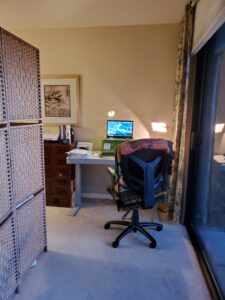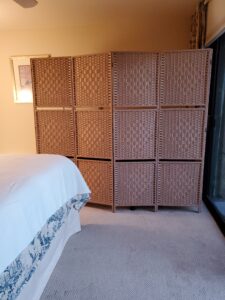Most of us are still working from home these days and some of us have even decided that working from home is a little slice of heaven and plan to stay this way as long as we can. Here are some tips to maximize your productivity:
1. Claim your physical spaces
This includes both your personal spaces and your workspaces. Even if your “office” is a corner in a bedroom like mine is, create at least a visual divider. Personal space on one side; workspace on the other. If you haven’t done this yet, Amazon sells a wide variety of room dividers/screens and they aren’t terribly expensive. Mine arrived within a couple of days so, if you’re working from home even part-time it’s still worth getting one. “Arriving at the office” means opening my screen so my workspace is visible. “Leaving the office” means closing it off. Just having that visible cue and the ritual of opening and closing helps me keep work and home better separated. I’m aware of the difference in my mind and can feel the difference in my body.
It’s not always possible to have even a corner in a separate room or part of the house that you can leave set up and just block off visually. I started out in our kitchen while our adult daughter stayed with us at the beginning of the pandemic. This meant setting up and taking down my “office.” It’s easy to fall into just leaving everything set up but protect your spaces – take the time to set up as you “arrive” at your office and put it away to signal to everyone, including yourself, that you are “leaving” the office. This may be as simple as covering your workspace with a neutral-colored sheet (so it might blend in more with your wall color) or a pretty scarf or throw blanket. Just having the workspace covered visually can be enough of a reminder that you aren’t at work anymore.


2. Protect your mental/emotional spaces
When working from home it’s easy to feel like the workday never ends. After all, you’re home all the time, so you’re technically able to work at all hours. If you see the laptop still open, it’s easy to quickly check your email or look to see if someone’s posted something on a listserv you follow. Don’t fall into this trap. Set a schedule of specific hours each day that you are to work and stick to it. During the off hours, close off your workspace, close the laptop lid or turn off your computer, and turn away when you find yourself tempted to peak. The same goes for your phone!!
3. Be productive, not just busy
There’s a difference between being busy and being productive. Checking email, texts, and voicemail mostly fall under the category of being busy. Being productive means taking some kind of action. This is when you’re crossing things off of your To-Do list — writing a brief; making sales calls, or researching data for a project. Ask yourself at the end of the day, “What did I accomplish?” You need to be able to answer with an actionable step.
4. Break up the Day
Most of us work best with small breaks. It gives us the time we need to rest and recharge. Schedule them throughout the day, 15 minutes here, 20 minutes there. Play with it and see what is the optimal amount of time you can work in a stretch and be productive and what is the optimal length of a break for you to come back feeling ready to be productive again. Use that time to go for a short walk or call and catch up with a friend. And in the middle of the day, step away from your computer and eat lunch. A colleague of mine uses his lunch hour to watch Saturday Night Live clips on YouTube. He says laughing for that time completely turns off his brain for a while and he returns to his desk feeling refreshed and recharged. Maybe the podcast listed below will give you a chuckle.